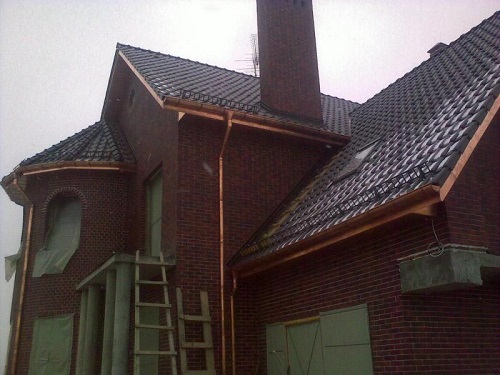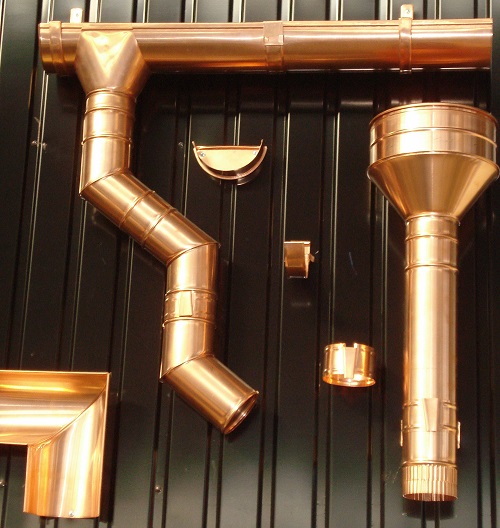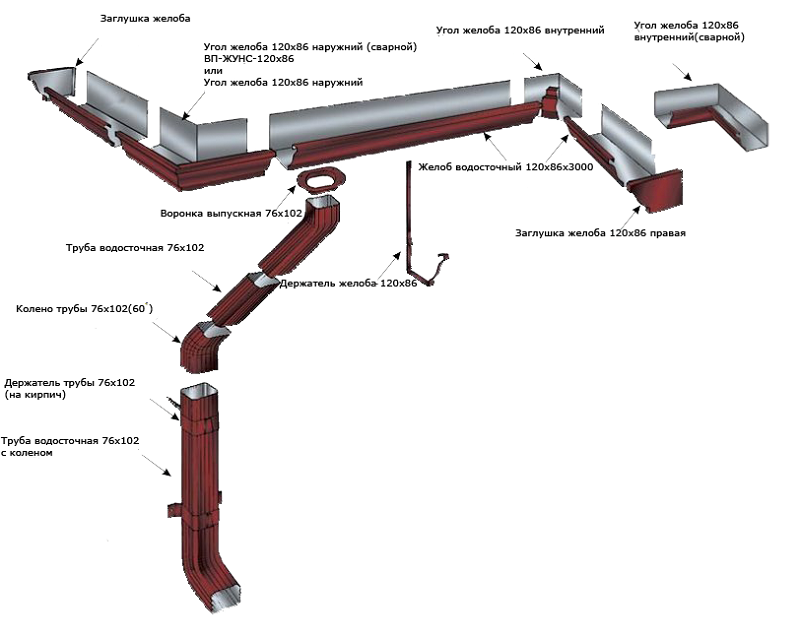A gutter is necessary in order to ensure the drainage of water flowing down the slopes of the roof. Without its use, moisture will collect at the base of the walls of the house or fall on the walls and windows. Obviously, the appearance of the building will not be the best if the finishing material is regularly exposed to water. On the other hand, such a system should have a service life comparable to what is laid for the roof structure. This is the reason that caused the emergence of a variety of solutions for water drainage. Someone uses plastic gutters, and someone liked the seam roof made of copper, and therefore a copper gutter system is installed.
Content
Types of drains

Copper is a relatively heavy metal, the color of which can vary from red to pink. It is attractive for creating a roof because it has a very long service life. For example, steel structures may not last for decades, although sometimes there are exceptions to the rules. The same gutters of urban buildings often perform their functions for decades, but they are regularly updated by teams of specialists. The second competitor to copper is plastic, which lasts up to a quarter of a century.
The plastic design is relatively light in weight, but its strength leaves much to be desired. For example, a strong wind is unlikely to harm the metal, but plastic may well “fly away”. On the other hand, plastic hardly retains water, so the thickness of the ice crust on its surface is minimal. All these differences are certainly interesting, but they cannot compare with what the copper drain offers. The first and main feature of copper in the role of roofing material is that its service life is several times greater than that of plastic or galvanized metal. Below we will talk more about the features of this type of roof.
Copper features
When using this metal in the drainage system, it does not require the use of any protective technologies. For several years, due to interaction with oxygen, the metal is coated with an oxide film of a brown or greenish hue. It is called "patina" and it is she who guarantees a very long service life of red metal.

The copper drain is pleasing to the eye and is durable, but it also has a drawback. Like seam roofs made of copper, the system of pipes and trays is afraid of pollution. If a large amount of foliage, twigs or other debris accumulates here, they will need to be removed. Otherwise, the destruction of the material will begin, which means that replacement will be required. In such a situation, you can’t talk about 150 years that a copper construction can serve your home.
The second feature of red metal systems is that they have an exceptional appearance. Moreover, the overall impression can be enhanced through the use of special solutions. For example, the design of the ends of the pipes is performed in the form of dragon heads, creating a kind of color. Temperature extremes, ultraviolet light, dangerous for plastics, as well as other factors will not be able to cause any harm when a copper drain is used.

I must say that here there were some shortcomings. Even copper is not perfect, but it is one of the best options.The problem is that for the installation of plastic elements you don’t need any special skills, but just correctly written instructions are enough, but with copper this kind of “trick” will not work. Red metal is noble and allows only professionals to establish themselves. When a layman is involved in this work, there is a risk of damage to the drain, pipes or fasteners, which will ultimately lead to a logical result. The service life and reliability of the structure will fall, and some of the expensive elements will soon require replacement.
Copper drains do not support fire and themselves cannot be a cause of fire, however, a sufficiently high temperature will harm copper elements, but other materials and thin steel also have this problem. There are no special problems with negative temperatures either: the metal has such an expansion coefficient that allows it to deform without the appearance of irreversible damage due to the formation of ice.
Mounting Methods
Elements can be installed in various ways:
- Mechanical. This method is quite common, but it cannot guarantee perfect reliability. It is worth noting that the creation of a monolithic structure is always a preferable option than the combination of a certain number of individual elements, however, it must be remembered that other factors often influence.
- By welding. Welding makes it easy to turn a copper drain into a single system, but the problem here is complex. The fact is that due to heating, copper sheets begin to absorb hydrogen, and oxygen, on the contrary, is released. This leads to the fact that the metal becomes brittle, so today this method has not received much distribution.
- By soldering. This method is based on the use of special solders, fluxes and equipment. The most attractive method is capillary brazing, which allows you to bypass the problem of the occurrence of brittle zones in places of heating.
The system device should be such as to exclude possible overflows over the edge. Moreover, it is required to choose products of the corresponding standard size. Copper drains are rectangular or round, but also oval. Also, one should not forget about the possibility of using elements that have some kind of decorative ornament.
Gutter construction
The first thing you should pay attention to is the location of the gutter, which is usually stretched along the entire roof. This element is not the only one, so below we will consider the rest in more detail:

- Gutter. Copper drains are used with copper roofs. Of course, other options are possible, but this one is optimal. Pitched roofs are covered with copper using a seam roof. At the end of each slope there is a gutter of copper, the task of which is to collect water. It is thanks to him that the walls, windows and the earth around the base do not get wet.
- The corners of the gutter. They are internal or external. The former are needed for those cases when a multi-gable roof is created, having a complex configuration, and the latter are indispensable in any building to connect the gutters passing on different sides of the building.
- Funnel. It connects the horizontal and vertical parts of the system, directing the flow of water down. After the funnel, special bends are placed or immediately a pipe if the cornice does not protrude too far beyond the walls of the building.
- Hardware. A hook is used to mount the gutter, and hooks on copper gutters are also required from copper, and the pipes are attached by round clamps that securely fix them to the walls.
- Stubs. These elements are necessary to close part of the gutter and to avoid water leakage from this side.
In addition to these elements, various types of elbows, S-contours, tees and funnels of the original design can be used.Any part of the system can receive decorative elements that are suitable for creating a special atmosphere around the building.
The advantages of copper drains
Copper is a very ductile metal that can take various forms. It is for this reason that a variety of jewelry is made from copper to change the appearance of the building. Copper drains, which are often created using the lower knee in the shape of the head of a mythical animal, did not become an exception, and other elements often have one or another ornament.
The second feature of copper is already casually mentioned by us above. It is about its reliability and durability. Due to the fact that a patina forms on the surface of the material, it easily resists any atmospheric influences with minimal care by humans.
The gutter assembled by experts is a reliable system that not only lasts a long time, but also differs by the ability to perform simple repairs. Even if the sheets were joined by soldering, there are no special problems during the replacement of the damaged area.
The fourth “plus” to the piggy bank of advantages is that the copper drain is very easy to clear of ice. Red metal has a high thermal conductivity, so a little heating is enough for the ice to begin to slide and leave the pipe. On this, the advantages of the metal itself end, but here the systems created with its use add a couple more useful features.

Modern copper structures can boast of the absence of gaps between the individual elements, even if the connection was carried out mechanically. This is achieved due to the thoughtful design and the use of special rubber seals, thanks to which it is not necessary to carry out additional sealing of the joints.
Copper is a soft metal, therefore, to strengthen the structure, the copper drainage system is made of elements that are equipped with stiffeners.
Types of copper drains
Today, three types of such products are used: natural copper, oxidized and patinated. In the first case, you get real red metal, which for the first time will delight the eye with bright reflections of the sun, and at sunset the house will acquire a unique look. Over time, the oxidation process will cause the color of the metal to change until the patina creates a noble dark green hue, providing not only an ideal match to the roofing material, but also protection against the destruction of copper.
Patinated copper gutter is a structure that has undergone the above changes at the factory. There is already a patina here, which means you don’t have to rack your brains over how to choose the right color option, because the color of the product will not change over time. Oxidized copper is an intermediate stage between normal and patinated.

Copper gutter is not the cheapest purchase, but it is ideal for a building whose roof is made of copper sheets. Moreover, the properties of such a metal make it more attractive than galvanized steel or plastic, provided that the material component of the issue does not play a decisive role.
Summing up, we note that copper is pointless to use when a cheap and short-lived roof covering is mounted. If its replacement is planned in 10-15 years, then the copper drain will be only an empty investment, because during the repair of the roof it may be necessary to dismantle it.





Alas, no comments yet. Be the first!